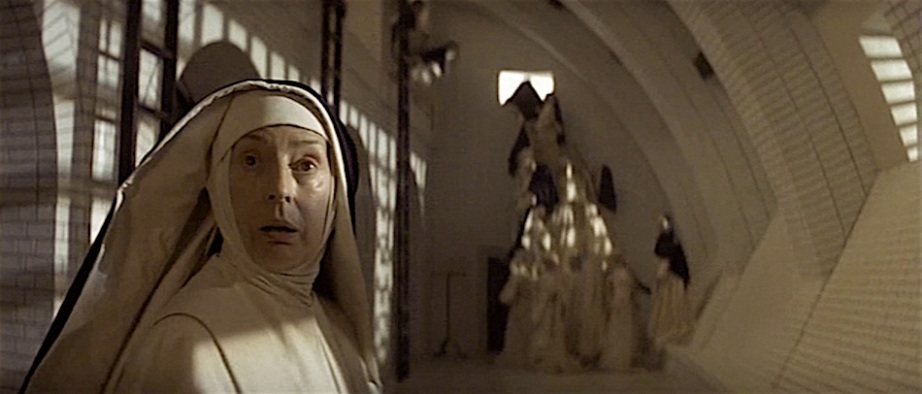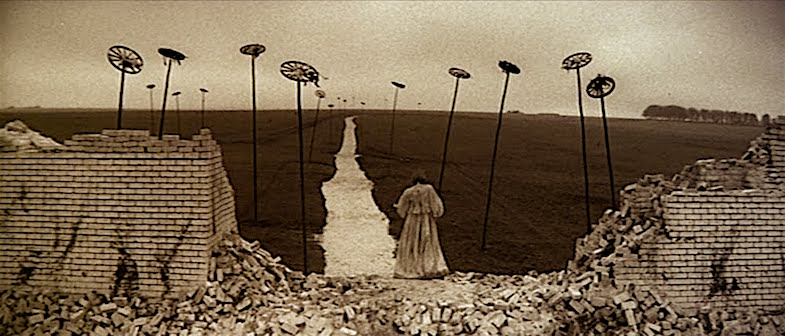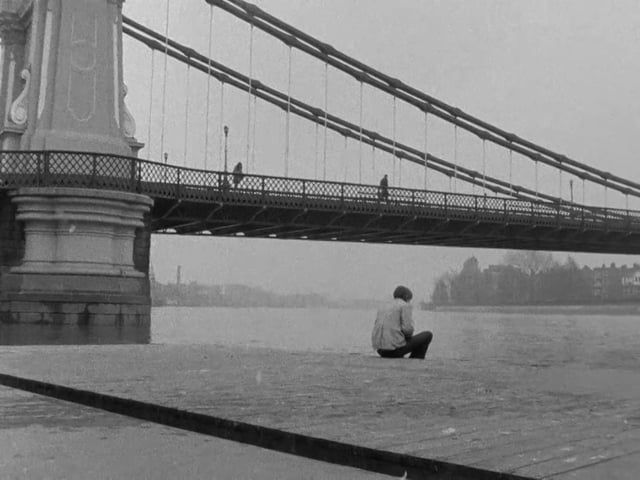Barbet Schroeder has always been interested in human obsessions and the dynamic of relationships, but when he got the idea to make Maîtresse he added something rather strange: Comedy. If you have never seen his infamous 1975 film, you should be aware of several things prior to watching it. The first of which is that this is essentially a very dark comedy about an unlikely love between a professional Dominatrix and a somewhat dim-witted would-be-thug. The second is that it is probably the closest a film has come to capturing the true idea of BDSM as something more than a simple desire — for Ariane (Bulle Ogier) and her clients, it is a true obsession. While she might attempt to keep her professional life hidden in the strange world isolated in a cloistered series of rooms beneath her apartment, it becomes clear that this world is more than a way to earn money. Elements of her sadism have already worked their way into her sunny world.

Stylish lady with some secrets…
Bulle Ogier
Maîtresse
Barbet Schroeder, 1975
Cinematography | Néstor Almendros
Like her clients, this is an obsession meant to be hidden from the rest of the world to see. The third is that Maîtresse is a very graphic film. This is not a movie for the faint of heart. The final and most important general statement about Maîtresse is that it is a highly artistic and well-crafted film. While it does not deserve to be listed or thought of as Shock Cinema, it is a most certainly highly provocative work. Schroeder is an intellectually restrained artist, but he is most certainly putting himself in the role of provocateur when it comes to this unforgettable and odd movie.
When Barbet Schroeder began production of Maîtresse in 1974 he knew he was creating a provocative film, but he had no idea just how difficult it would be to secure distribution in 1975. It would be more than a couple of years before this infamous film would be seen much at all. The film was essentially banned and censored for over six years after the initial debut. The UK would prove the toughest nut to crack. Interestingly it was not so much due to the exploration into the world of a French Dominatrix which included graphic depictions of BDSM activities, nor was it actually due to anything tied up in fetish and kink and it certainly wasn’t the horrific visit to a Paris horse meat slaughterhouse. The bottomline reason Schroeder’s film was refused release into the UK was because it featured the back view of a vulva.
To give the British Board of Film Classification their due — they were smart enough to actually state that the film’s refusal was related to the “excessive” degrees of fetishism. The real reason BBFC denied release to the film was not because a person was being whipped, it was because the audience could see her vulva. The board did not mind that the audience could see a penis being severely mistreated. They were upset that the man seemed to enjoy having his genitals mistreated.
Maîtresse was screened and received a limited release in the US. The distributor assigned the film an X-rating on its own. So limited was the release that very few film critics actually reviewed it. The New York Times quite liked it. But the film became notorious with relatively few people having ever actually seen it. That all changed when The Criterion Collection remastered and released it to DVD in 2004.
While the uncensored theatrical cut of Maîtresse had been released to the UK via DVD starting in 2003, the transfers were not solid. Under their Flipside Editions, The British Film Institute released it to Blu-ray in 2012. Blu quality enhanced, the BFI release is actually superior to the Criterion Collection pressing. There has been some very loose rumors that Criterion may give the film another image/sound boost to re-issue to Blu-ray, but it is rather unlikely. The film’s graphic scene filmed in an actual horse slaughterhouse is truly horrific to watch. This scene is most likely intended to act as a sort of metaphor for a powerful beast being reduced to a powerless victim ultimately utilized as food. The scene arrives in the story when the leading man is feeling powerless and emasculated.

Even playing “footsie” takes a turn…
Gerard Depardieu / Bulle Ogier
Maîtresse
Barbet Schroeder, 1975
Cinematography | Néstor Almendros
Note: Even by 1975 horse meat had already become a taboo form of food in more than a couple of countries. However it should be noted that while it has dramatically shifted away from favor, there are still butcher shops in France specifically reserved for the sale of this meat. All the same this is an alarming scene that will most likely put off a good number of people. As an FYI, Schroeder’s use of the footage is almost tame when compared to Rainer Werner Fassbinder’s use of Goethe recitation as the audience is led through the horrors of a slaughterhouse in 1978’s In a Year of 13 Moons. Fassbinder employed this form of human brutality to create a metaphor for fascism and despair. Unlike Schroeder’s movie, Fassbinder’s film is not even remotely a comedy. Still both films carry a repugnant reputation for screening graphic screening of animal slaughter. Consider yourself warned.
All the same, it is annoying that the Criterion transfer is inferior to the one released by BFI Flipside Edition.

Wig and make-up perfected as well as an enhanced transfer.
Maîtresse
Barbet Schroeder, 1975
BFI Flipside, 2012
While one might expect a 1975 French film to be dated, it really isn’t. Even the clothing is not particularly 1970’s tacky. Let’s not forget that Karl Lagerfeld was in charge of costume design. …And the line between S&M to Lagerfeld is fairly short in distance.
And speaking of Sadomasochism, Maîtresse is one of the few films to actually craft a realistic depiction of this subculture. While many speak of Sadomasochism, the reality is that a true Sadist is not going to derive much pleasure from role-play. And while one might think of a Masochist as passive or willing victim, the true master of S&M role-play is always the Masochist. In other words, there is a very dark side to the games that many adults play. In Maîtresse the role playing is most definitely in action, but the games are being played with the rules loose and usually hidden. During the first half of the film it would appear that Ariane takes no particular pleasure in what she does in the lair beneath her bright apartment, but Schroeder slowly begins to reveal aspects of her true nature as the film moves forward.

Going down below to a domestic torture garden…
Bulle Ogier
Maîtresse
Barbet Schroeder, 1975
Cinematography | Néstor Almendros
Ariane seems to take true delight in feeding a collection of venus fly trap plants. Her high-scale bathtub has been crafted to include a bottom chamber that she has filled with water snakes or eels who feed off small fish which she her maid/assistant pours into the mix. And of course as the battle of the sexes ensues we see examples of her need to remain firmly in the position of dominance.

Tighten up the gimp…
Bulle Ogier & Client
Maîtresse
Barbet Schroeder, 1975
Cinematography | Néstor Almendros
The film’s perspective belongs to leading man of the story. Gérard Depardieu’s Olivier appears to be a harmless sort of guy, but it only takes a small opportunity and he is ready to take up the grift as burglar. And it only takes another moment or two before we realize that this burly young man is a criminal. The film’s plot begins as Olivier and a pal break into what they think is an empty Parisian apartment. Like voyeurs, we follow these knuckleheads into a creepy dark space. With only a flashlight to provide limited perspective, we understand within a few seconds that this is no ordinary apartment. The small light reveals gimp masks, gas masks, latex & rubber suits, a hanging noose, a sinister looking dental chair, something like a torture rack, loads of odd surgical type equipment, dildos, baby bottles, diapers, a wide variety of torture tools and a terrified naked man shivering in a dog pen. This might all read a bit funnier than it is. I first saw this movie in Cambridge back in the 1990’s and it was and remains a genuinely creepy opening sequence. Soon these two thugs find themselves handcuffed together and to a radiator as Bulle Ogier’s Ariane tends to her clients.

Sexual attraction, crime, money and a battle for control is about to begin…
Gerard Depardieu / Bulle Ogier
Maîtresse
Barbet Schroeder, 1975
Cinematography | Néstor Almendros
This is a filmmaker’s movie. Gerard Depardieu is well cast in the type of role for which he was best known in his youth — a sort of primally sexy gentle giant. It is really through Olivier‘s eyes that the audience sees the film. While this man is far from innocent, he clearly has no understanding of the world to which he has entered. But it is both comical and interesting that he finds himself deeply attracted to Ariane. His desire for her begins as she one-up’s both he and his pal by managing to cuff them together with no hope of escape. His attraction only builds as she offers him a chance to make some money and leads him further into the dark corners of her domestic torture garden. As they approach a man dressed in female bondage gear, she demands that the client get on all fours. She straddles him and positions Olivier directly in front of the masochist’s face. Olivier looks more curious than shocked. She unzips her burglar’s fly, pulls out his penis and demands that he urinate in the client’s face. Olivier‘s eyes never leave those of Ariane. As we hear the urine release he shares a passionate kiss with her. Suddenly this brute of a man is in love.

And now we begin your punishment…
A Masochist Client & Bulle Ogier
Maîtresse
Barbet Schroeder, 1975
Cinematography | Néstor Almendros
After a night of what appears to be romance funded by Ariane, the two lie in bed. There are no professions of love, but it is clear it is there. Schroeder’s screenplay and Bulle Ogier’s careful performance require no words for the audience to understand that much of her attraction / fondness for Olivier is grounded in his mix of dull intellect, brutish but placid assertions of dominance. Of course the deal-sealer for Ariane is that this man is unabashedly almost worshiping in his adoration. There is also no need for discussion regarding Olivier‘s confusion regarding the downstairs world of his love’s professional life. All Depardieu need to do is offer a glance and we know that he is even more confused than those of us in the audience.
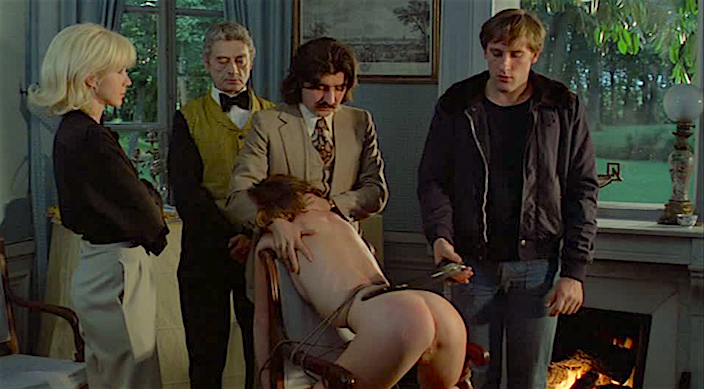
And this must be the naughty girl in need of punishment… Bulls Ogier / Wealthy Clients / Gerard Depardieu Maîtresse Barbet Schroeder, 1975 Cinematography | Néstor Almendros
When Ariane essentially tricks him into visiting a friend in the country, he has no idea that she is leading him into a Dominatrix scenario involving a group of wealthy devotees. Confused, unsure and fearful of being judged as less than a man Olivier agreed to remove his belt and whip the pretty and only female player in the chateau. It is clear that he simply does not understand why a tough whipping would provide pleasure. Eager to demonstrate his abilities to his new lover, he opts to softly tease the masochist’s vulva. Of course this only demonstrates his misunderstanding of this type of desire. The wealthy clients are amused as is Ariane. But Olivier and the audience are confused and worried that he is being used and reduced to some sort of walking joke.
When I saw Maîtresse for the first time back in the 1990’s I had been informed that it was a dark comedy. At this time it was hard for me to accept it as comedy. It seemed to me that the film was aiming far deeper than one anticipates from the genre. Despite my own desire to interpret the movie in a different way there were elements that simply did not seem to fit the action on the screen.

Néstor Almendros captures our Mistress in perfect frame to emerge with a halo for the man who will become obsessed. Meet the Whore-Madonna concept personified… Bulls Ogier Maîtresse Barbet Schroeder, 1975 Cinematography | Néstor Almendros
Carlos D’Alessio’s musical score seemed odd. It is a rather charming bit of work that never fits into the world we and Olivier are exploring. In addition some of the darkest moments contained within the movie have no musical accompaniment. Seeing the film again after it had been added to The Criterion Collection, the comedy of Maîtresse hit me. Certainly not a comic experience that generates laughs as much as amusement — this is more a sense of bemusement. This is, of course, a French film. I love French cinema, but no one else presents comedy quite like the French. This level of dark comedy or comédie de l’ cruels has become more familiar outside of French cinema in the past decade. John Magary’s recent brilliant independent American film, The Mend, presents an incisive and rage-filled study of two brothers as the sort of dark comedy one might expect from France. Serious studies of humanity taking a turn toward the comical is not so odd to most of us anymore. Despite all of the transgressions and darker elements of identity, Maîtresse is most certainly a comedy.

Watching love’s persona and identity change presents more than a little confusion for the boyfriend. Bulle Ogier / Gerard Depardieu Maîtresse Barbet Schroeder, 1975 Cinematography | Néstor Almendros
A key to understanding Maîtresse is to know that nothing we see is eroticized. This is not an erotic film.
When we are given glimpses into the Maitresse’s world of punishment and humiliation it is either directly related to Olivier‘s sneaking around peaking or listening. Schroeder spent a good deal of time researching the subject matter of the film as he felt no connection to the world of S&M. Much of Bulle Ogier’s character is based on an actual dominatrix. He gained her trust and she agreed to allow she and several of her clients to be used in the film itself. Long before the idea of digital effects existed, Schroeder carefully placed the actual dominatrix in relation to his actress/wife’s positions. The actual members of the 1970’s Parisian BDSM Underground wear masks to protect their identity, but they are willfully accepting their mistresses’ punishments. All is filmed to make it look as if Ogier is the one applying nails, needles and other manipulations. Filmed without typical movie lighting or other stylings, these transgressive acts are presented with only the sounds that were occurring at the time of filming. The result is often jarring and more than a little shocking, but never eroticized.
Nothing is ever explained beyond the most limited of discussion. Like Olivier, we are left with only what we see and might already understand separate from the film. Unlike Olivier, we are hopefully not quite so simple in our thinking and reasoning. And let’s hope we are not male chauvinist pigs. Olivier has a deep-seated need to dominate his woman. Having grown into a world of cruelty and crime, he has no trouble formulating the idea that his girl is a prostitute in need of a strong pimp. He wants the role of her pimp. And he wants to find a way to help her earn even more money. Because it is all about money. Right?!?

One simple bully who has met his match without even fully realizing it…
Gerard Depardieu Maîtresse Barbet Schroeder, 1975 Cinematography | Néstor Almendros
Tragically for Olivier, he is unable to grasp that Ariane needs no protecting and certainly no pimp. Ariane never states an opinion, but it is clear that she does not identify as a prostitute and would never even consider the idea of pimp in her existence. As Olivier becomes more and more obsessed with understanding what Ariane does and why people pay her to do it — he becomes even more determined to know all of her secrets. The identity of a certain person constantly being mentioned in relation to money either with her maid or on one of her two phones consumes Olivier.
It is at this point of the story that we fully begin to understand the depth of Ariane‘s own perverse sadistic urges. It would not take much for her to simply explain it all to Olivier, but she has far too much fun watching him struggle for his grounding and fret over the details of her life.
Even when Olivier’s tendencies toward domestic abuse begin to flare up, she maintains her sense of control.
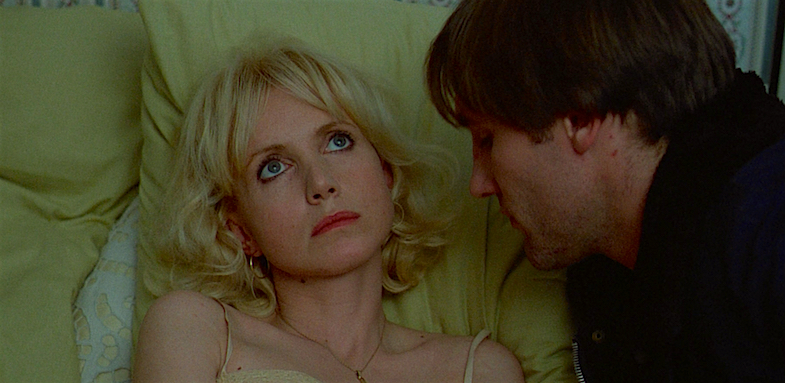
He’s just royally screwed a lot up, but there is simply too much joy to be found in his desperate need for her love and forgiveness. Who has the power now? Bulle Ogier / Gerard Depardieu Maîtresse Barbet Schroeder, 1975 Cinematography | Néstor Almendros
When he puts his huge hands around her slender throat she plays it off as if a game. Poor Olivier doesn’t even pick up that he has failed to scare her. Later when he finally pushes things too far and our Maîtresse has had enough, she head-butts Olivier so hard blood begins to pour from his nose. Clearly shocked by her strength, his reaction is to attempt to warn Ariane that she too has been harmed. He is concerned. Ariane is unbothered by the self-damage inflicted by her head-butting. She is seething with anger.
It is the dim-witted Olivier who is emotionally crushed. This is not the first time we have seen this rough and huge man fall to pieces over his girl. Control and cruelty are needs and that refuse to stay in that dark cave of torture secretly adjoined to her private home. These needs are not being fully satisfied by respecting most of her clients’ wishes and safe words. A Sadist wants real control and a victim. She is happy to play along with Olivier‘s limited view of women for the pleasure his pain provides.
She may look the part of angel, but this aspect is in appearance only.
Another key scene involves some personal and rather rough role-play between Ariane and Olivier. Schroeder wisely shoots this scene in a particularly ambiguous way. It looks like a violent public fight between the two characters as reality with the looming threat of rape. When the two end up in a garden shed of an elderly woman we hear Ariane‘s screams. As the poor old woman rushes to come to the aide of the petit blond woman, Olivier emerges with a switchblade pointed to kill. When Ariane walks out of the shed she is still pulling up her skirt. We might expect that she would feel empathy for the elder woman, but instead she merely leans into Olivier and mockingly suggests he leave the poor “old dear” alone. She skips away without even waiting to see what Olivier might do.
We never actually know if this was a bit of role-playing or a real scenario that Ariane has manifested / navigated for some sadistic fun.

Punishing a key client, this is not a woman who needs or wants the protection of a man.
Bulle Ogier
Maîtresse
Barbet Schroeder, 1975
Cinematography | Néstor Almendros
Despite the dark elements of the on-screen actions, this is a story about the battle of the sexes. It is also an odd 1970’s twist on Feminisim. The key word here is “odd.” In many ways it almost seems a mistake that Barbet Schroeder opted to sculpt a very twisted romantic comedy from the BDSM clay of his story. There are so many aspects of Bulle Ogier’s Ariane it seems a bit of a waste of a great actress that she is unable to explore them. As I’ve stated several times, not much is ever explained about the title character.

Forever lingering with mystery… Bulle Ogier Maîtresse Barbet Schroeder, 1975 Cinematography | Néstor Almendros
The subplot of Ariane‘s situation is only mentioned in passing. I’m not sure I even fully noticed it upon my first viewing some 20 years ago, but it is wrought with dramatic potential. La Maîtresse is the mother of an elementary school age child. An older gentleman (who may or may not be the child’s father) appears to have taken custody of the child. We may not know the full story here, but it would appear that Ariane is fine with this arrangement and most likely has intended it to be this way. When we see her with her child she clearly feels a stronger bond to her Doberman Pinscher. A beloved pet she has named Texas and claims to have trained to kill upon demand. We do not know if this is true, but it seems likely to be an accurate claim. Her young son appears to attempt to gain his mother’s attention, but Ariane is far more interested with Texas. When the boy walks off with his guardian/father, Ariane appears bored, but fixated on the dog. We never learn the name of her son, but she is more than happy to sneak away and join Olivier on a very strange drive in which the battle for power takes a surprising turn.

Orgasm without brakes! Hey, who is really driving this car anyway?!?! Gerard Depardieu / Bulle Ogier Maîtresse Barbet Schroeder, 1975 Cinematography | Néstor Almendros
Barbet Schroeder’s Maîtresse is an uncomplicated film about some very complicated people. The choice to keep it unexplained and unexplored is intentional. And as it turns out this was a very clever and wise decision. Maîtresse pulls us in just deep enough to make us squirm but never so far out that we need to grasp for air. It also prevents the film from slipping into a psychological realm that would ultimately prove disappointing.
Why?
Well sometimes life’s complications and the obsessions to which it leads are too murky to actually articulate.
Matty Stanfield, 1.28.2016

































